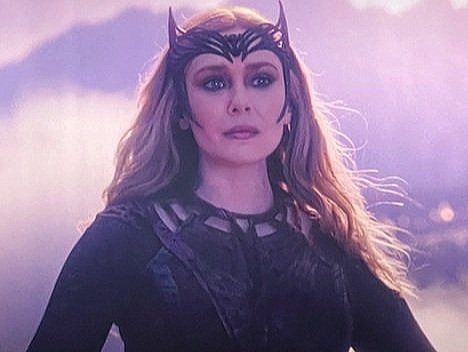Doctor Strange: Multiverse of Madness – (Rated) R, Maybe?
Doctor Strange has appeared in multiple Marvel movies since his debut in 2016, and he finally received a new movie all his own. The first Dr. Strange movie was the first film in the MCU to touch upon the more supernatural and mystical side of the Marvel universe. It was a solid Marvel movie, with possibly the best, or at least the most trippiest effects I’ve ever seen. Though it probably didn’t quite hit my top five in the MCU at the time, the sequel, however, eliminated those ranks. Let’s dive in and see why Dr. Strange: Multiverse of Madness has made the cut.
Sam Rami
First, this film has a different director than the previous Dr. Strange movie. Scott Derrickson, who directed the first, and was supposed to direct this one, was switched out for Sam Rami (known for the Evil Dead films and the original Spiderman trilogy with Tobey McGuire). While Scott Derrickson did a fantastic job with the first, Sam Raimi’s direction is what I feel this movie needed. Fair warning, Multiverse of Madness is probably the most violent MCU film, as well as the creepiest, and as a fan of both violent and dark films, this definitely appealed to me. From the camera angles, make-up, audio and visual effects, it definitely screamed “Evil Dead”, and this was a good thing. While the film was still PG-13 it felt like it was on the cusp of being given an “R” rating, and actually made me question “Are they allowed to do that in a PG-13 movie?”.
Like most phase 4 MCU movies and television shows, the setting, of course takes place after Avengers: Endgame as well as the events of WandaVision. Dr. Strange encounters a mysterious girl named America Chavez, after saving her from Gargantuan (aka: Copyright free Shuma Gorath), who he actually encountered in a strange dream the previous night. Strange and Wong decide to protect Chavez when learning she’s from another universe, and is being pursued by otherworldly monsters to absorb her ability to travel through the multiverse. Strange notices the creatures were summoned through witchcraft, goes to consult the one person that would know said witchcraft (Wanda Maximoff), and secrets are revealed to detrimental effects. This movie focuses on how Strange goes through questionable lengths to be a hero, and the repercussions of those actions. While he may not be a full-on anti-hero like Venom or the Punisher, his decisions come at the expense of someone or something else that is also working with or for him. The film also demonstrates how Strange can be stereotyped and expected to act the same within the multiverse as he constantly has to prove himself to be the opposite.
Strange (Benedict Cumberbatch ) and Wong (Benedict Wong)
All the characters from previous films reprise their roles, with a few surprises. Strange (played by Benedict Cumberbatch) is starting to feel like he is taking over the “Iron Man” persona of being the “sarcastic genius with the one liners”, but with maybe a pinch more cynicism. Despite being one of the most powerful MCU heroes, this film shows his personal struggles and how being one of the most powerful doesn't mean you're the happiest. America Chavez, played by Mexican-American actress Xochitl Gomez, is introduced to the MCU and while she is a walking talking McGuffin, this movie does a great job of establishing her as the newest hero in this cinematic universe as they set the foundation by establishing her struggles, desires, and her beginnings in becoming a superhero.
Wong, who has been appearing in almost every aspect of the MCU-phase four, is reprised by Benedict Wong. He has a slightly bigger role here as he's most connected to Dr. Strange. Working as the Sorcerer Supreme, he guides and fights alongside Dr. Strange, while never stealing the spotlight. The dynamic between Strange and Wong is entertaining as they bicker like an old married couple; with Wong constantly mocking Strange for his mistakes, while Strange refuses to bow to him as the Sorcerer Supreme (mainly because Stephen got robbed of the position due to him being blipped away after Infinity War). Strange's love interest, Christine Palmer (played by Rachel McAdams) finally makes a return. She still plays Strange’s exclusive love interest in the sense that the main character, sadly, doesn't “get” her, but she is still there to support him (Think Anne from the Venom films). Even though you can't help but feel bad for Strange, McAdams does a great job of helping him out and helping him grow as a person and a hero, without making you feel angry with her about not being with him.
The character that really stole the show for me was Wanda Maximoff (or Scarlet Witch), played by Elizabeth Olsen. She plays a more antagonistic role in the film and is probably one of the best in the MCU. She’s brutal, frightening, and creative in her methods of attack. Coming in as an X-Men fan, she was always my favorite female character in the MCU, and I always wanted to see her get more screen time and action, and THIS. FILM. DELIVERED. Olsen does a fantastic job being such a great menace, and while some parts show her inner psyche struggling with what she's doing, this was simultaneously the best and worst time to be a Scarlet Witch fan.
Shuma Gorath
There were only a few flaws with the movie, but, the few issues I had were more external, than the movie itself. One being the usage of Shuma Gorath, the gargantuan, one-eyed monster that Strange and Wong fought in New York; his full form was sadly limited due to the movie rights for him held by the creators of Conan the Barbarian. Second, was the use of the multiverse. I was hoping for more cameos and teasing of future Marvel characters and while the internet rumors didn't help us with this, I can understand Marvel wanting to show restraint, especially after Sony’s Spiderman: No Way Home’s mishap. It also doesn't help that one of the most impactful cameos was spoiled from a trailer (see here). Speaking of cameos, I do wish there was more time spent in other universes as the movie focused on two to three characters that weren’t part of the main universe. Finally, as a Scarlet Witch fan, I do wish the movie ended a bit differently. I can understand the reasoning behind what happened, but her character switch may have been too drastic, and may not have been foreshadowed enough from WandaVision for me to understand it.
Strange vs. Gargantos from Superhero Society
Dr. Strange: Multiverse of Madness is an action packed, intense spectacle with that “Sam Raimi comedic horror” charm. The fights and effects are intense and show off the spectacle that the more mystical side of the MCU has to offer that makes these features so memorable. Seeing the movie a few times, there were some effects that I didn't notice on earlier encounters. One common critique of the film is that it isn't helping point the Phase four series in a particular direction like the former ones did to Avengers: Endgame. My argument here is that not all of the MCU films are necessary toward a “major” end goal like the mega war with Thanos. For example, Captain America 2 and its uncovering of Hydra, and the elimination of SHIELD; Avengers: Age of Ultron, with the introduction of Quicksilver and Wanda Maximoff, and let’s not forget Ant-Man’s Scott Lang and his quirkiness, were all brief introductions that built up to a more internal Civil War. And while Civil War led to an end goal, the conflict was minute, personal, and intimate. For me, I’m personally interested in the potential conflicts in the characters, like the “teaser” in the post credit scene of this film, rather than a mega threat that's been teased in other projects like the Loki series.
If you want a superhero movie with some magic, mysticism, and horror, Dr. Strange: The Multiverse of Madness gives it to you in abundance. Nothing more, nothing less.
4/5 Stars











